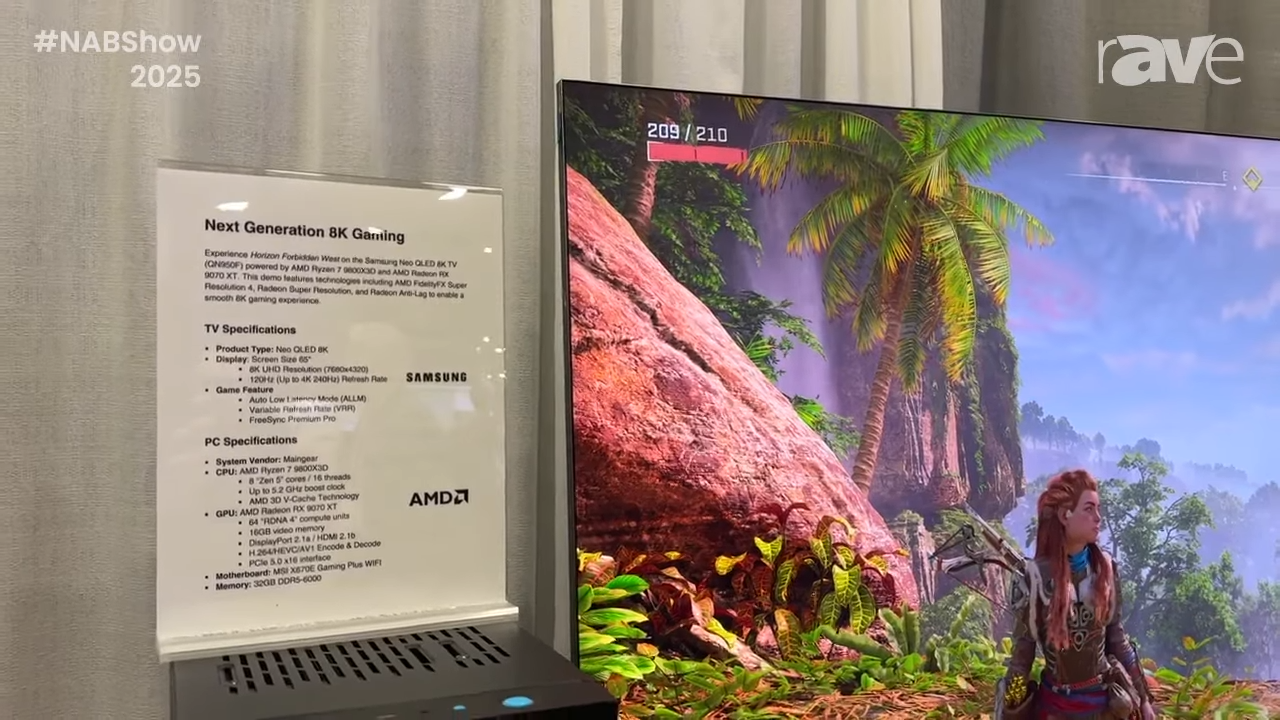AMD and Samsung unveil world’s first 8K 120 Hz gaming TV, but we’re not ready to call it the next big step

Table of Contents
During the NAB Show 2025 in Las Vegas, the 8K Association showed off a “world first” for 8K@120Hz gaming on HDMI 2.1. The core hardware behind this involved AMD’s latest RX 9070 XT and Ryzen 7 9800X3D CPU in a PC supplied by MainGear, paired with a Samsung Neo QLED 8K TV.
According to the 8K Association, the TV was a special modified version of Samsung’s Neo QLED line flown in for the event from Korea with features like Auto Low Latency Mode, VRR, and FreeSync Premium Pro, which was running Guerrilla’s Horizon Forbidden West game, which is known to be well-optimized.
Prime Day is finally here! Find all the biggest tech and PC deals below.
- Sapphire 11348-03-20G Pulse AMD Radeon™ RX 9070 XT Was $779 Now $739
- AMD Ryzen 7 7800X3D 8-Core, 16-Thread Desktop Processor Was $449 Now $341
- ASUS RTX™ 5060 OC Edition Graphics Card Was $379 Now $339
- LG 77-Inch Class OLED evo AI 4K C5 Series Smart TV Was $3,696 Now $2,796
- Intel® Core™ i7-14700K New Gaming Desktop Was $320.99 Now $274
- Lexar 2TB NM1090 w/HeatSink SSD PCIe Gen5x4 NVMe M.2 Was $281.97 Now $214.98
- Apple Watch Series 10 GPS + Cellular 42mm case Smartwatch Was $499.99 Now $379.99
- ASUS ROG Strix G16 (2025) 16" FHD, RTX 5060 gaming laptop Was $1,499.99 Now $1,274.99
- Apple iPad mini (A17 Pro): Apple Intelligence Was $499.99 Now $379.99
*Prices and savings subject to change. Click through to get the current prices.
Upscaled to 8K using AMD’s FSR
Interestingly, the game was rendered at 5K and then internally upscaled to 8K using AMD’s FSR 3 technology. Now, we’re not sure if this was something lost in translation, as the 8K Association described FSR 3 as “ML-based,” which, as we know, only applies to the much improved FSR 4. So perhaps it was actually FSR 4 being used, not FSR 3. Anywho, the signal was sent to the TV using HDMI 2.1b with DSC (Display Stream Compression) support.
4K is demanding enough when running modern games
Now, as much of a world first as this is, the real-world utility of 8K is quite questionable. For one, running games at 8K puts four times more strain on your graphics card compared to 4K, which even high-end systems struggle with. While upscaling technologies like AMD’s FSR and Nvidia’s DLSS may help you reach 8K resolution with 4K frame rates, upscaled 8K shouldn’t be compared to native 4K.
To add to that, the jump from 540p to 1080p is greater than from 1080p to 4K, and the difference from 4K to 8K is even less noticeable subjectively, especially on many current display sizes. Image quality is also a concern due to upscaling, and there's very little TV or movie content encoded in true 8K.
As for gaming, 8K still feels like overkill, and we expect it to remain that way for many years, as modern systems already reach their potential trying to deliver a 60 FPS 4K native experience without the need for upscaling or frame generation. On top of all that, lower resolutions such as 1080p remain relevant, especially in the case of competitive games, as claimed by BenQ.

